Overview
- Brief Narrative
- Pocketknife, likely recovered from a temporary pit furnace at Chelmno killing center in German-occupied Poland, during an archaeological excavation in 1986 and 1987. Killing operations at Chelmno commenced on December 8, 1941. Prisoners were taken to a camp at a manor house (Schlosslager) in the village to undress and relinquish their valuables. They were then loaded into a gas van where they were killed. The van was then driven 2.5 miles northwest of the village to a camp in the Rzuchowski forest (Waldlager), where the bodies were dumped into mass graves. The large number of corpses created a threat of disease and discovery by Allied forces, so the bodies were exhumed and burned in seven primitive pit furnaces. In the fall of 1942, the furnaces were replaced with two open-air crematoria consisting of concrete foundations topped by a grate of train rails. In March 1943, transports to Chelmno stopped, and the manor house and open-air crematoria in the forest were demolished. Deportations to Chelmno resumed from June to July 1944, to facilitate the liquidation of the Łódź ghetto. In this second phase, the entire killing process was carried out in the forest camp (Waldlager), necessitating the construction of new buildings. The Germans abandoned the camp on January 17, 1945, having killed over 172,000 people. The excavations of 1986-87, and later work have identified additional furnaces, crematoria, and mass graves at the site.
- Date
-
use:
before 1942 September
recovered: 1986-1987
- Geography
-
recovery:
Chelmno (Concentration camp);
Chełmno (Koło, Poland)
- Credit Line
- United States Holocaust Memorial Museum Collection, Gift of Muzeum Okręgowe w Koninie
Physical Details
- Classification
-
Tools and Equipment
- Category
-
Cutting tools
- Object Type
-
Pocketknives (lcsh)
- Genre/Form
- Knives.
- Physical Description
- Flat, corroded, folding pocketknife with long, straight edges and rounded ends. The knife handle consists of two, thin metal sides held together by short, flat-headed, cylindrical pins at four points along the length of the handle: one at one end, one in the center, and two at the opposite end. These pins would have anchored up to four blades or attachments within the handle, and acted as hinges. The blades or attachments were designed to swing out from within the handle for use while extended. The heavily corroded, iron remnants of the tools protrude from the interior of the handle as orange-brown accretions. The surface of the handle is covered by a layer of green-brown corrosion. The end of the handle with a single pin is pinched inward from use.
- Dimensions
- overall: Height: 1.250 inches (3.175 cm) | Width: 3.250 inches (8.255 cm) | Depth: 0.250 inches (0.635 cm)
- Materials
- overall : metal, iron
Rights & Restrictions
- Conditions on Access
- No restrictions on access
- Conditions on Use
- No restrictions on use
Keywords & Subjects
- Topical Term
- Archaeology and history. Crematoriums--Poland. Execution sites--Excavation--Material culture. Executions and executioners--Poland--History. Exhumation--Cremation--Poland. Gas vans (Gas chambers)--Poland. Genocide. Mass burials--Poland. World War, 1939-1945--Occupied territories.
- Geographic Name
- Chełmno (Koło, Poland) Rzuchowa (Poland)
Administrative Notes
- Legal Status
- Permanent Collection
- Provenance
- The pocket knife was donated to the United States Holocaust Memorial Museum in 1989 by the Muzeum Okręgowe w Koninie.
- Record last modified:
- 2024-09-09 13:54:44
- This page:
- https://collections.ushmm.org/search/catalog/irn1083
Download & Licensing
In-Person Research
- By Appointment
- Request 21 Days in Advance of Visit
- Plan a Research Visit
- Request to See This Object
Contact Us
Also in Muzeum Okregowe w Konine collection
The collection consists of concrete, a map, utensils, clothing accessories, and other small personal artifacts recovered from the site of Chelmno killing center operated by the German SS and police authorities in German-occupied Poland.
Date: 1941-1945
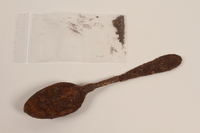
Rusted tablespoon recovered from Chelmno killing center
Object
Metal tablespoon, likely recovered from a temporary pit furnace at Chelmno killing center in German-occupied Poland, during an archaeological excavation in 1986 and 1987. Killing operations at Chelmno commenced on December 8, 1941. Prisoners were taken to a camp at a manor house (Schlosslager) in the village to undress and relinquish their valuables. They were then loaded into a gas van where they were killed. The van was then driven 2.5 miles northwest of the village to a camp in the Rzuchowski forest (Waldlager), where the bodies were dumped into mass graves. The large number of corpses created a threat of disease and discovery by Allied forces, so the bodies were exhumed and burned in seven primitive pit furnaces. In the fall of 1942, the furnaces were replaced with two open-air crematoria consisting of concrete foundations topped by a grate of train rails. In March 1943, transports to Chelmno stopped, and the manor house and open-air crematoria in the forest were demolished. Deportations to Chelmno resumed from June to July 1944, to facilitate the liquidation of the Łódź ghetto. In this second phase, the entire killing process was carried out in the forest camp (Waldlager), necessitating the construction of new buildings. The Germans abandoned the camp on January 17, 1945, having killed over 172,000 people. The excavations of 1986-87, and later work have identified additional furnaces, crematoria, and mass graves at the site.
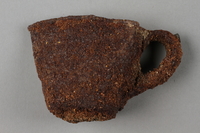
Rusted, crushed cup recovered from Chelmno killing center
Object
Metal cup, likely recovered from a temporary pit furnace at Chelmno killing center in German-occupied Poland, during an archaeological excavation in 1986 and 1987. Killing operations at Chelmno commenced on December 8, 1941. Prisoners were taken to a camp at a manor house (Schlosslager) in the village to undress and relinquish their valuables. They were then loaded into a gas van where they were killed. The van was then driven 2.5 miles northwest of the village to a camp in the Rzuchowski forest (Waldlager), where the bodies were dumped into mass graves. The large number of corpses created a threat of disease and discovery by Allied forces, so the bodies were exhumed and burned in seven primitive pit furnaces. In the fall of 1942, the furnaces were replaced with two open-air crematoria consisting of concrete foundations topped by a grate of train rails. In March 1943, transports to Chelmno stopped, and the manor house and open-air crematoria in the forest were demolished. Deportations to Chelmno resumed from June to July 1944, to facilitate the liquidation of the Łódź ghetto. In this second phase, the entire killing process was carried out in the forest camp (Waldlager), necessitating the construction of new buildings. The Germans abandoned the camp on January 17, 1945, having killed over 172,000 people. The excavations of 1986-87, and later work have identified additional furnaces, crematoria, and mass graves at the site.
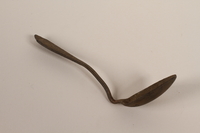
Metal teaspoon recovered from Chelmno killing center
Object
Metal teaspoon, likely recovered from a temporary pit furnace at Chelmno killing center in German-occupied Poland, during an archaeological excavation in 1986 and 1987. Killing operations at Chelmno commenced on December 8, 1941. Prisoners were taken to a camp at a manor house (Schlosslager) in the village to undress and relinquish their valuables. They were then loaded into a gas van where they were killed. The van was then driven 2.5 miles northwest of the village to a camp in the Rzuchowski forest (Waldlager), where the bodies were dumped into mass graves. The large number of corpses created a threat of disease and discovery by Allied forces, so the bodies were exhumed and burned in seven primitive pit furnaces. In the fall of 1942, the furnaces were replaced with two open-air crematoria consisting of concrete foundations topped by a grate of train rails. In March 1943, transports to Chelmno stopped, and the manor house and open-air crematoria in the forest were demolished. Deportations to Chelmno resumed from June to July 1944, to facilitate the liquidation of the Łódź ghetto. In this second phase, the entire killing process was carried out in the forest camp (Waldlager), necessitating the construction of new buildings. The Germans abandoned the camp on January 17, 1945, having killed over 172,000 people. The excavations of 1986-87, and later work have identified additional furnaces, crematoria, and mass graves at the site.
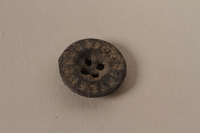
Small metal button recovered from Chelmno killing center
Object
Metal button, likely recovered from a temporary pit furnace at Chelmno killing center in German-occupied Poland, during an archaeological excavation in 1986 and 1987. Killing operations at Chelmno commenced on December 8, 1941. Prisoners were taken to a camp at a manor house (Schlosslager) in the village to undress and relinquish their valuables. They were then loaded into a gas van where they were killed. The van was then driven 2.5 miles northwest of the village to a camp in the Rzuchowski forest (Waldlager), where the bodies were dumped into mass graves. The large number of corpses created a threat of disease and discovery by Allied forces, so the bodies were exhumed and burned in seven primitive pit furnaces. In the fall of 1942, the furnaces were replaced with two open-air crematoria consisting of concrete foundations topped by a grate of train rails. In March 1943, transports to Chelmno stopped, and the manor house and open-air crematoria in the forest were demolished. Deportations to Chelmno resumed from June to July 1944, to facilitate the liquidation of the Łódź ghetto. In this second phase, the entire killing process was carried out in the forest camp (Waldlager), necessitating the construction of new buildings. The Germans abandoned the camp on January 17, 1945, having killed over 172,000 people. The excavations of 1986-87, and later work have identified additional furnaces, crematoria, and mass graves at the site.
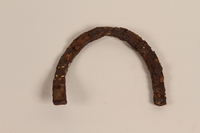
Rusted horseshoe-shaped heelplate recovered from Chelmno killing center
Object
Metal heel plate, likely recovered from a temporary pit furnace at Chelmno killing center in German-occupied Poland, during an archaeological excavation in 1986 and 1987. Killing operations at Chelmno commenced on December 8, 1941. Prisoners were taken to a camp at a manor house (Schlosslager) in the village to undress and relinquish their valuables. They were then loaded into a gas van where they were killed. The van was then driven 2.5 miles northwest of the village to a camp in the Rzuchowski forest (Waldlager), where the bodies were dumped into mass graves. The large number of corpses created a threat of disease and discovery by Allied forces, so the bodies were exhumed and burned in seven primitive pit furnaces. In the fall of 1942, the furnaces were replaced with two open-air crematoria consisting of concrete foundations topped by a grate of train rails. In March 1943, transports to Chelmno stopped, and the manor house and open-air crematoria in the forest were demolished. Deportations to Chelmno resumed from June to July 1944, to facilitate the liquidation of the Łódź ghetto. In this second phase, the entire killing process was carried out in the forest camp (Waldlager), necessitating the construction of new buildings. The Germans abandoned the camp on January 17, 1945, having killed over 172,000 people. The excavations of 1986-87, and later work have identified additional furnaces, crematoria, and mass graves at the site.
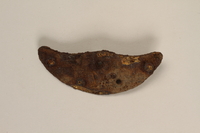
Rusted heel plate with screw recovered from Chelmno killing center
Object
Metal heel plate, likely recovered from a temporary pit furnace at Chelmno killing center in German-occupied Poland, during an archaeological excavation in 1986 and 1987. Killing operations at Chelmno commenced on December 8, 1941. Prisoners were taken to a camp at a manor house (Schlosslager) in the village to undress and relinquish their valuables. They were then loaded into a gas van where they were killed. The van was then driven 2.5 miles northwest of the village to a camp in the Rzuchowski forest (Waldlager), where the bodies were dumped into mass graves. The large number of corpses created a threat of disease and discovery by Allied forces, so the bodies were exhumed and burned in seven primitive pit furnaces. In the fall of 1942, the furnaces were replaced with two open-air crematoria consisting of concrete foundations topped by a grate of train rails. In March 1943, transports to Chelmno stopped, and the manor house and open-air crematoria in the forest were demolished. Deportations to Chelmno resumed from June to July 1944, to facilitate the liquidation of the Łódź ghetto. In this second phase, the entire killing process was carried out in the forest camp (Waldlager), necessitating the construction of new buildings. The Germans abandoned the camp on January 17, 1945, having killed over 172,000 people. The excavations of 1986-87, and later work have identified additional furnaces, crematoria, and mass graves at the site.
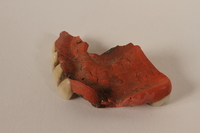
Partial upper plate of a denture with five teeth recovered from Chelmno killing center
Object
Fragment of an upper denture, likely recovered from a temporary pit furnace at Chelmno killing center in German-occupied Poland, during an archaeological excavation in 1986 and 1987. Killing operations at Chelmno commenced on December 8, 1941. Prisoners were taken to a camp at a manor house (Schlosslager) in the village to undress and relinquish their valuables. They were then loaded into a gas van where they were killed. The van was then driven 2.5 miles northwest of the village to a camp in the Rzuchowski forest (Waldlager), where the bodies were dumped into mass graves. The large number of corpses created a threat of disease and discovery by Allied forces, so the bodies were exhumed and burned in seven primitive pit furnaces. In the fall of 1942, the furnaces were replaced with two open-air crematoria consisting of concrete foundations topped by a grate of train rails. In March 1943, transports to Chelmno stopped, and the manor house and open-air crematoria in the forest were demolished. Deportations to Chelmno resumed from June to July 1944, to facilitate the liquidation of the Łódź ghetto. In this second phase, the entire killing process was carried out in the forest camp (Waldlager), necessitating the construction of new buildings. The Germans abandoned the camp on January 17, 1945, having killed over 172,000 people. The excavations of 1986-87, and later work have identified additional furnaces, crematoria, and mass graves at the site.
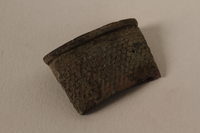
Metal tailor's thimble recovered from Chelmno killing center
Object
Metal thimble, likely recovered from a temporary pit furnace at Chelmno killing center in German-occupied Poland, during an archaeological excavation in 1986 and 1987. Killing operations at Chelmno commenced on December 8, 1941. Prisoners were taken to a camp at a manor house (Schlosslager) in the village to undress and relinquish their valuables. They were then loaded into a gas van where they were killed. The van was then driven 2.5 miles northwest of the village to a camp in the Rzuchowski forest (Waldlager), where the bodies were dumped into mass graves. The large number of corpses created a threat of disease and discovery by Allied forces, so the bodies were exhumed and burned in seven primitive pit furnaces. In the fall of 1942, the furnaces were replaced with two open-air crematoria consisting of concrete foundations topped by a grate of train rails. In March 1943, transports to Chelmno stopped, and the manor house and open-air crematoria in the forest were demolished. Deportations to Chelmno resumed from June to July 1944, to facilitate the liquidation of the Łódź ghetto. In this second phase, the entire killing process was carried out in the forest camp (Waldlager), necessitating the construction of new buildings. The Germans abandoned the camp on January 17, 1945, having killed over 172,000 people. The excavations of 1986-87, and later work have identified additional furnaces, crematoria, and mass graves at the site.
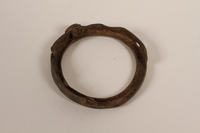
Partial pocket watch casing recovered from Chelmno killing center
Object
Partial pocket watch casing, likely recovered from a temporary pit furnace at Chelmno killing center in German-occupied Poland, during an archaeological excavation in 1986 and 1987. Killing operations at Chelmno commenced on December 8, 1941. Prisoners were taken to a camp at a manor house (Schlosslager) in the village to undress and relinquish their valuables. They were then loaded into a gas van where they were killed. The van was then driven 2.5 miles northwest of the village to a camp in the Rzuchowski forest (Waldlager), where the bodies were dumped into mass graves. The large number of corpses created a threat of disease and discovery by Allied forces, so the bodies were exhumed and burned in seven primitive pit furnaces. In the fall of 1942, the furnaces were replaced with two open-air crematoria consisting of concrete foundations topped by a grate of train rails. In March 1943, transports to Chelmno stopped, and the manor house and open-air crematoria in the forest were demolished. Deportations to Chelmno resumed from June to July 1944, to facilitate the liquidation of the Łódź ghetto. In this second phase, the entire killing process was carried out in the forest camp (Waldlager), necessitating the construction of new buildings. The Germans abandoned the camp on January 17, 1945, having killed over 172,000 people. The excavations of 1986-87, and later work have identified additional furnaces, crematoria, and mass graves at the site.
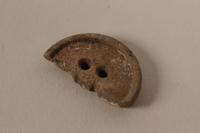
Partial button recovered from Chelmno killing center
Object
Partial button, likely recovered from a temporary pit furnace at Chelmno killing center in German-occupied Poland, during an archaeological excavation in 1986 and 1987. Killing operations at Chelmno commenced on December 8, 1941. Prisoners were taken to a camp at a manor house (Schlosslager) in the village to undress and relinquish their valuables. They were then loaded into a gas van where they were killed. The van was then driven 2.5 miles northwest of the village to a camp in the Rzuchowski forest (Waldlager), where the bodies were dumped into mass graves. The large number of corpses created a threat of disease and discovery by Allied forces, so the bodies were exhumed and burned in seven primitive pit furnaces. In the fall of 1942, the furnaces were replaced with two open-air crematoria consisting of concrete foundations topped by a grate of train rails. In March 1943, transports to Chelmno stopped, and the manor house and open-air crematoria in the forest were demolished. Deportations to Chelmno resumed from June to July 1944, to facilitate the liquidation of the Łódź ghetto. In this second phase, the entire killing process was carried out in the forest camp (Waldlager), necessitating the construction of new buildings. The Germans abandoned the camp on January 17, 1945, having killed over 172,000 people. The excavations of 1986-87, and later work have identified additional furnaces, crematoria, and mass graves at the site.
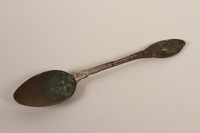
Metal teaspoon recovered from Chelmno killing center
Object
Metal teaspoon, likely recovered from a temporary pit furnace at Chelmno killing center in German-occupied Poland, during an archaeological excavation in 1986 and 1987. Killing operations at Chelmno commenced on December 8, 1941. Prisoners were taken to a camp at a manor house (Schlosslager) in the village to undress and relinquish their valuables. They were then loaded into a gas van where they were killed. The van was then driven 2.5 miles northwest of the village to a camp in the Rzuchowski forest (Waldlager), where the bodies were dumped into mass graves. The large number of corpses created a threat of disease and discovery by Allied forces, so the bodies were exhumed and burned in seven primitive pit furnaces. In the fall of 1942, the furnaces were replaced with two open-air crematoria consisting of concrete foundations topped by a grate of train rails. In March 1943, transports to Chelmno stopped, and the manor house and open-air crematoria in the forest were demolished. Deportations to Chelmno resumed from June to July 1944, to facilitate the liquidation of the Łódź ghetto. In this second phase, the entire killing process was carried out in the forest camp (Waldlager), necessitating the construction of new buildings. The Germans abandoned the camp on January 17, 1945, having killed over 172,000 people. The excavations of 1986-87, and later work have identified additional furnaces, crematoria, and mass graves at the site.
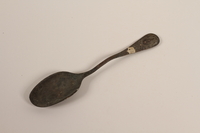
Metal tablespoon recovered from Chelmno killing center
Object
Metal tablespoon, likely recovered from a temporary pit furnace at Chelmno killing center in German-occupied Poland, during an archaeological excavation in 1986 and 1987. Killing operations at Chelmno commenced on December 8, 1941. Prisoners were taken to a camp at a manor house (Schlosslager) in the village to undress and relinquish their valuables. They were then loaded into a gas van where they were killed. The van was then driven 2.5 miles northwest of the village to a camp in the Rzuchowski forest (Waldlager), where the bodies were dumped into mass graves. The large number of corpses created a threat of disease and discovery by Allied forces, so the bodies were exhumed and burned in seven primitive pit furnaces. In the fall of 1942, the furnaces were replaced with two open-air crematoria consisting of concrete foundations topped by a grate of train rails. In March 1943, transports to Chelmno stopped, and the manor house and open-air crematoria in the forest were demolished. Deportations to Chelmno resumed from June to July 1944, to facilitate the liquidation of the Łódź ghetto. In this second phase, the entire killing process was carried out in the forest camp (Waldlager), necessitating the construction of new buildings. The Germans abandoned the camp on January 17, 1945, having killed over 172,000 people. The excavations of 1986-87, and later work have identified additional furnaces, crematoria, and mass graves at the site.
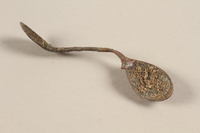
Bent, rusted teaspoon recovered from Chelmno killing center
Object
Metal teaspoon, likely recovered from a temporary pit furnace at Chelmno killing center in German-occupied Poland, during an archaeological excavation in 1986 and 1987. Killing operations at Chelmno commenced on December 8, 1941. Prisoners were taken to a camp at a manor house (Schlosslager) in the village to undress and relinquish their valuables. They were then loaded into a gas van where they were killed. The van was then driven 2.5 miles northwest of the village to a camp in the Rzuchowski forest (Waldlager), where the bodies were dumped into mass graves. The large number of corpses created a threat of disease and discovery by Allied forces, so the bodies were exhumed and burned in seven primitive pit furnaces. In the fall of 1942, the furnaces were replaced with two open-air crematoria consisting of concrete foundations topped by a grate of train rails. In March 1943, transports to Chelmno stopped, and the manor house and open-air crematoria in the forest were demolished. Deportations to Chelmno resumed from June to July 1944, to facilitate the liquidation of the Łódź ghetto. In this second phase, the entire killing process was carried out in the forest camp (Waldlager), necessitating the construction of new buildings. The Germans abandoned the camp on January 17, 1945, having killed over 172,000 people. The excavations of 1986-87, and later work have identified additional furnaces, crematoria, and mass graves at the site.
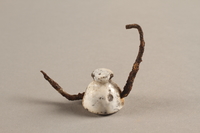
Porcelain and metal bottle stopper recovered from Chelmno killing center
Object
Porcelain bottle stopper, likely recovered from a temporary pit furnace at Chelmno killing center in German-occupied Poland, during an archaeological excavation in 1986 and 1987. Killing operations at Chelmno commenced on December 8, 1941. Prisoners were taken to a camp at a manor house (Schlosslager) in the village to undress and relinquish their valuables. They were then loaded into a gas van where they were killed. The van was then driven 2.5 miles northwest of the village to a camp in the Rzuchowski forest (Waldlager), where the bodies were dumped into mass graves. The large number of corpses created a threat of disease and discovery by Allied forces, so the bodies were exhumed and burned in seven primitive pit furnaces. In the fall of 1942, the furnaces were replaced with two open-air crematoria consisting of concrete foundations topped by a grate of train rails. In March 1943, transports to Chelmno stopped, and the manor house and open-air crematoria in the forest were demolished. Deportations to Chelmno resumed from June to July 1944, to facilitate the liquidation of the Łódź ghetto. In this second phase, the entire killing process was carried out in the forest camp (Waldlager), necessitating the construction of new buildings. The Germans abandoned the camp on January 17, 1945, having killed over 172,000 people. The excavations of 1986-87, and later work have identified additional furnaces, crematoria, and mass graves at the site.
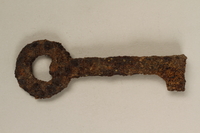
Small metal key recovered from Chelmno killing center
Object
Metal key, likely recovered from a temporary pit furnace at Chelmno killing center in German-occupied Poland, during an archaeological excavation in 1986 and 1987. Killing operations at Chelmno commenced on December 8, 1941. Prisoners were taken to a camp at a manor house (Schlosslager) in the village to undress and relinquish their valuables. They were then loaded into a gas van where they were killed. The van was then driven 2.5 miles northwest of the village to a camp in the Rzuchowski forest (Waldlager), where the bodies were dumped into mass graves. The large number of corpses created a threat of disease and discovery by Allied forces, so the bodies were exhumed and burned in seven primitive pit furnaces. In the fall of 1942, the furnaces were replaced with two open-air crematoria consisting of concrete foundations topped by a grate of train rails. In March 1943, transports to Chelmno stopped, and the manor house and open-air crematoria in the forest were demolished. Deportations to Chelmno resumed from June to July 1944, to facilitate the liquidation of the Łódź ghetto. In this second phase, the entire killing process was carried out in the forest camp (Waldlager), necessitating the construction of new buildings. The Germans abandoned the camp on January 17, 1945, having killed over 172,000 people. The excavations of 1986-87, and later work have identified additional furnaces, crematoria, and mass graves at the site.
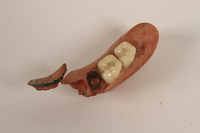
Partial lower plate of a denture with two molars recovered from Chelmno killing center
Object
Fragment of a lower denture, likely recovered from a temporary pit furnace at Chelmno killing center in German-occupied Poland, during an archaeological excavation in 1986 and 1987. Killing operations at Chelmno commenced on December 8, 1941. Prisoners were taken to a camp at a manor house (Schlosslager) in the village to undress and relinquish their valuables. They were then loaded into a gas van where they were killed. The van was then driven 2.5 miles northwest of the village to a camp in the Rzuchowski forest (Waldlager), where the bodies were dumped into mass graves. The large number of corpses created a threat of disease and discovery by Allied forces, so the bodies were exhumed and burned in seven primitive pit furnaces. In the fall of 1942, the furnaces were replaced with two open-air crematoria consisting of concrete foundations topped by a grate of train rails. In March 1943, transports to Chelmno stopped, and the manor house and open-air crematoria in the forest were demolished. Deportations to Chelmno resumed from June to July 1944, to facilitate the liquidation of the Łódź ghetto. In this second phase, the entire killing process was carried out in the forest camp (Waldlager), necessitating the construction of new buildings. The Germans abandoned the camp on January 17, 1945, having killed over 172,000 people. The excavations of 1986-87, and later work have identified additional furnaces, crematoria, and mass graves at the site.
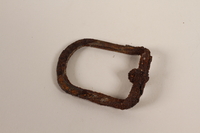
Metal buckle frame recovered from Chelmno killing center
Object
Metal buckle frame, likely recovered from a temporary pit furnace at Chelmno killing center in German-occupied Poland, during an archaeological excavation in 1986 and 1987. Killing operations at Chelmno commenced on December 8, 1941. Prisoners were taken to a camp at a manor house (Schlosslager) in the village to undress and relinquish their valuables. They were then loaded into a gas van where they were killed. The van was then driven 2.5 miles northwest of the village to a camp in the Rzuchowski forest (Waldlager), where the bodies were dumped into mass graves. The large number of corpses created a threat of disease and discovery by Allied forces, so the bodies were exhumed and burned in seven primitive pit furnaces. In the fall of 1942, the furnaces were replaced with two open-air crematoria consisting of concrete foundations topped by a grate of train rails. In March 1943, transports to Chelmno stopped, and the manor house and open-air crematoria in the forest were demolished. Deportations to Chelmno resumed from June to July 1944, to facilitate the liquidation of the Łódź ghetto. In this second phase, the entire killing process was carried out in the forest camp (Waldlager), necessitating the construction of new buildings. The Germans abandoned the camp on January 17, 1945, having killed over 172,000 people. The excavations of 1986-87, and later work have identified additional furnaces, crematoria, and mass graves at the site.
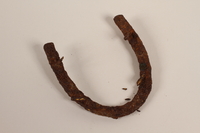
Metal horseshoe-shaped heel plate recovered from Chelmno killing center
Object
Metal heel plate, likely recovered from a temporary pit furnace at Chelmno killing center in German-occupied Poland, during an archaeological excavation in 1986 and 1987. Killing operations at Chelmno commenced on December 8, 1941. Prisoners were taken to a camp at a manor house (Schlosslager) in the village to undress and relinquish their valuables. They were then loaded into a gas van where they were killed. The van was then driven 2.5 miles northwest of the village to a camp in the Rzuchowski forest (Waldlager), where the bodies were dumped into mass graves. The large number of corpses created a threat of disease and discovery by Allied forces, so the bodies were exhumed and burned in seven primitive pit furnaces. In the fall of 1942, the furnaces were replaced with two open-air crematoria consisting of concrete foundations topped by a grate of train rails. In March 1943, transports to Chelmno stopped, and the manor house and open-air crematoria in the forest were demolished. Deportations to Chelmno resumed from June to July 1944, to facilitate the liquidation of the Łódź ghetto. In this second phase, the entire killing process was carried out in the forest camp (Waldlager), necessitating the construction of new buildings. The Germans abandoned the camp on January 17, 1945, having killed over 172,000 people. The excavations of 1986-87, and later work have identified additional furnaces, crematoria, and mass graves at the site.
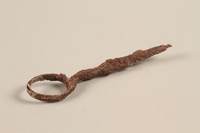
Small scissors in two pieces, recovered from Chelmno killing center
Object
Metal scissors, likely recovered from a temporary pit furnace at Chelmno killing center in German-occupied Poland, during an archaeological excavation in 1986 and 1987. Killing operations at Chelmno commenced on December 8, 1941. Prisoners were taken to a camp at a manor house (Schlosslager) in the village to undress and relinquish their valuables. They were then loaded into a gas van where they were killed. The van was then driven 2.5 miles northwest of the village to a camp in the Rzuchowski forest (Waldlager), where the bodies were dumped into mass graves. The large number of corpses created a threat of disease and discovery by Allied forces, so the bodies were exhumed and burned in seven primitive pit furnaces. In the fall of 1942, the furnaces were replaced with two open-air crematoria consisting of concrete foundations topped by a grate of train rails. In March 1943, transports to Chelmno stopped, and the manor house and open-air crematoria in the forest were demolished. Deportations to Chelmno resumed from June to July 1944, to facilitate the liquidation of the Łódź ghetto. In this second phase, the entire killing process was carried out in the forest camp (Waldlager), necessitating the construction of new buildings. The Germans abandoned the camp on January 17, 1945, having killed over 172,000 people. The excavations of 1986-87, and later work have identified additional furnaces, crematoria, and mass graves at the site.
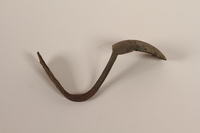
Metal teaspoon recovered from Chelmno killing center
Object
Metal teaspoon, likely recovered from a temporary pit furnace at Chelmno killing center in German-occupied Poland, during an archaeological excavation in 1986 and 1987. Killing operations at Chelmno commenced on December 8, 1941. Prisoners were taken to a camp at a manor house (Schlosslager) in the village to undress and relinquish their valuables. They were then loaded into a gas van where they were killed. The van was then driven 2.5 miles northwest of the village to a camp in the Rzuchowski forest (Waldlager), where the bodies were dumped into mass graves. The large number of corpses created a threat of disease and discovery by Allied forces, so the bodies were exhumed and burned in seven primitive pit furnaces. In the fall of 1942, the furnaces were replaced with two open-air crematoria consisting of concrete foundations topped by a grate of train rails. In March 1943, transports to Chelmno stopped, and the manor house and open-air crematoria in the forest were demolished. Deportations to Chelmno resumed from June to July 1944, to facilitate the liquidation of the Łódź ghetto. In this second phase, the entire killing process was carried out in the forest camp (Waldlager), necessitating the construction of new buildings. The Germans abandoned the camp on January 17, 1945, having killed over 172,000 people. The excavations of 1986-87, and later work have identified additional furnaces, crematoria, and mass graves at the site.
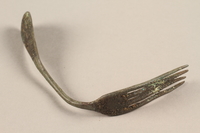
Bent metal fork recovered from Chelmno killing center
Object
Metal fork, likely recovered from a temporary pit furnace at Chelmno killing center in German-occupied Poland, during an archaeological excavation in 1986 and 1987. Killing operations at Chelmno commenced on December 8, 1941. Prisoners were taken to a camp at a manor house (Schlosslager) in the village to undress and relinquish their valuables. They were then loaded into a gas van where they were killed. The van was then driven 2.5 miles northwest of the village to a camp in the Rzuchowski forest (Waldlager), where the bodies were dumped into mass graves. The large number of corpses created a threat of disease and discovery by Allied forces, so the bodies were exhumed and burned in seven primitive pit furnaces. In the fall of 1942, the furnaces were replaced with two open-air crematoria consisting of concrete foundations topped by a grate of train rails. In March 1943, transports to Chelmno stopped, and the manor house and open-air crematoria in the forest were demolished. Deportations to Chelmno resumed from June to July 1944, to facilitate the liquidation of the Łódź ghetto. In this second phase, the entire killing process was carried out in the forest camp (Waldlager), necessitating the construction of new buildings. The Germans abandoned the camp on January 17, 1945, having killed over 172,000 people. The excavations of 1986-87, and later work have identified additional furnaces, crematoria, and mass graves at the site.
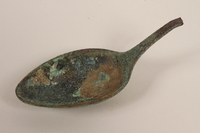
Metal tablespoon fragment recovered from Chelmno killing center
Object
Metal tablespoon, likely recovered from a temporary pit furnace at Chelmno killing center in German-occupied Poland, during an archaeological excavation in 1986 and 1987. Killing operations at Chelmno commenced on December 8, 1941. Prisoners were taken to a camp at a manor house (Schlosslager) in the village to undress and relinquish their valuables. They were then loaded into a gas van where they were killed. The van was then driven 2.5 miles northwest of the village to a camp in the Rzuchowski forest (Waldlager), where the bodies were dumped into mass graves. The large number of corpses created a threat of disease and discovery by Allied forces, so the bodies were exhumed and burned in seven primitive pit furnaces. In the fall of 1942, the furnaces were replaced with two open-air crematoria consisting of concrete foundations topped by a grate of train rails. In March 1943, transports to Chelmno stopped, and the manor house and open-air crematoria in the forest were demolished. Deportations to Chelmno resumed from June to July 1944, to facilitate the liquidation of the Łódź ghetto. In this second phase, the entire killing process was carried out in the forest camp (Waldlager), necessitating the construction of new buildings. The Germans abandoned the camp on January 17, 1945, having killed over 172,000 people. The excavations of 1986-87, and later work have identified additional furnaces, crematoria, and mass graves at the site.
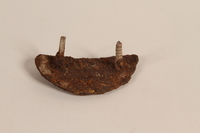
Rusted heel plate with a screw and nail recovered from Chelmno killing center
Object
Metal heel plate, likely recovered from a temporary pit furnace at Chelmno killing center in German-occupied Poland, during an archaeological excavation in 1986 and 1987. Killing operations at Chelmno commenced on December 8, 1941. Prisoners were taken to a camp at a manor house (Schlosslager) in the village to undress and relinquish their valuables. They were then loaded into a gas van where they were killed. The van was then driven 2.5 miles northwest of the village to a camp in the Rzuchowski forest (Waldlager), where the bodies were dumped into mass graves. The large number of corpses created a threat of disease and discovery by Allied forces, so the bodies were exhumed and burned in seven primitive pit furnaces. In the fall of 1942, the furnaces were replaced with two open-air crematoria consisting of concrete foundations topped by a grate of train rails. In March 1943, transports to Chelmno stopped, and the manor house and open-air crematoria in the forest were demolished. Deportations to Chelmno resumed from June to July 1944, to facilitate the liquidation of the Łódź ghetto. In this second phase, the entire killing process was carried out in the forest camp (Waldlager), necessitating the construction of new buildings. The Germans abandoned the camp on January 17, 1945, having killed over 172,000 people. The excavations of 1986-87, and later work have identified additional furnaces, crematoria, and mass graves at the site.
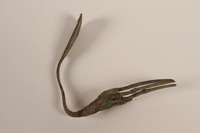
Metal fork recovered from Chelmno killing center
Object
Metal fork, likely recovered from a temporary pit furnace at Chelmno killing center in German-occupied Poland, during an archaeological excavation in 1986 and 1987. Killing operations at Chelmno commenced on December 8, 1941. Prisoners were taken to a camp at a manor house (Schlosslager) in the village to undress and relinquish their valuables. They were then loaded into a gas van where they were killed. The van was then driven 2.5 miles northwest of the village to a camp in the Rzuchowski forest (Waldlager), where the bodies were dumped into mass graves. The large number of corpses created a threat of disease and discovery by Allied forces, so the bodies were exhumed and burned in seven primitive pit furnaces. In the fall of 1942, the furnaces were replaced with two open-air crematoria consisting of concrete foundations topped by a grate of train rails. In March 1943, transports to Chelmno stopped, and the manor house and open-air crematoria in the forest were demolished. Deportations to Chelmno resumed from June to July 1944, to facilitate the liquidation of the Łódź ghetto. In this second phase, the entire killing process was carried out in the forest camp (Waldlager), necessitating the construction of new buildings. The Germans abandoned the camp on January 17, 1945, having killed over 172,000 people. The excavations of 1986-87, and later work have identified additional furnaces, crematoria, and mass graves at the site.
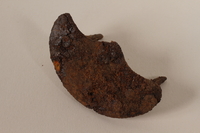
Corroded metal heel plate recovered from Chelmno killing center
Object
Metal heel plate, likely recovered from a temporary pit furnace at Chelmno killing center in German-occupied Poland, during an archaeological excavation in 1986 and 1987. Killing operations at Chelmno commenced on December 8, 1941. Prisoners were taken to a camp at a manor house (Schlosslager) in the village to undress and relinquish their valuables. They were then loaded into a gas van where they were killed. The van was then driven 2.5 miles northwest of the village to a camp in the Rzuchowski forest (Waldlager), where the bodies were dumped into mass graves. The large number of corpses created a threat of disease and discovery by Allied forces, so the bodies were exhumed and burned in seven primitive pit furnaces. In the fall of 1942, the furnaces were replaced with two open-air crematoria consisting of concrete foundations topped by a grate of train rails. In March 1943, transports to Chelmno stopped, and the manor house and open-air crematoria in the forest were demolished. Deportations to Chelmno resumed from June to July 1944, to facilitate the liquidation of the Łódź ghetto. In this second phase, the entire killing process was carried out in the forest camp (Waldlager), necessitating the construction of new buildings. The Germans abandoned the camp on January 17, 1945, having killed over 172,000 people. The excavations of 1986-87, and later work have identified additional furnaces, crematoria, and mass graves at the site.
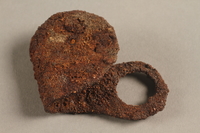
Rusted, bent metal shoehorn recovered from Chelmno killing center
Object
Metal shoehorn, likely recovered from a temporary pit furnace at Chelmno killing center in German-occupied Poland, during an archaeological excavation in 1986 and 1987. Killing operations at Chelmno commenced on December 8, 1941. Prisoners were taken to a camp at a manor house (Schlosslager) in the village to undress and relinquish their valuables. They were then loaded into a gas van where they were killed. The van was then driven 2.5 miles northwest of the village to a camp in the Rzuchowski forest (Waldlager), where the bodies were dumped into mass graves. The large number of corpses created a threat of disease and discovery by Allied forces, so the bodies were exhumed and burned in seven primitive pit furnaces. In the fall of 1942, the furnaces were replaced with two open-air crematoria consisting of concrete foundations topped by a grate of train rails. In March 1943, transports to Chelmno stopped, and the manor house and open-air crematoria in the forest were demolished. Deportations to Chelmno resumed from June to July 1944, to facilitate the liquidation of the Łódź ghetto. In this second phase, the entire killing process was carried out in the forest camp (Waldlager), necessitating the construction of new buildings. The Germans abandoned the camp on January 17, 1945, having killed over 172,000 people. The excavations of 1986-87, and later work have identified additional furnaces, crematoria, and mass graves at the site.
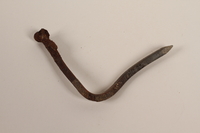
Nail recovered from Chelmno killing center
Object
Metal nail, likely recovered from a temporary pit furnace at Chelmno killing center in German-occupied Poland, during an archaeological excavation in 1986 and 1987. Killing operations at Chelmno commenced on December 8, 1941. Prisoners were taken to a camp at a manor house (Schlosslager) in the village to undress and relinquish their valuables. They were then loaded into a gas van where they were killed. The van was then driven 2.5 miles northwest of the village to a camp in the Rzuchowski forest (Waldlager), where the bodies were dumped into mass graves. The large number of corpses created a threat of disease and discovery by Allied forces, so the bodies were exhumed and burned in seven primitive pit furnaces. In the fall of 1942, the furnaces were replaced with two open-air crematoria consisting of concrete foundations topped by a grate of train rails. In March 1943, transports to Chelmno stopped, and the manor house and open-air crematoria in the forest were demolished. Deportations to Chelmno resumed from June to July 1944, to facilitate the liquidation of the Łódź ghetto. In this second phase, the entire killing process was carried out in the forest camp (Waldlager), necessitating the construction of new buildings. The Germans abandoned the camp on January 17, 1945, having killed over 172,000 people. The excavations of 1986-87, and later work have identified additional furnaces, crematoria, and mass graves at the site.
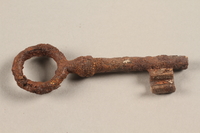
Large, rusted metal key recovered from Chelmno killing center
Object
Metal skeleton key, likely recovered from a temporary pit furnace at Chelmno killing center in German-occupied Poland, during an archaeological excavation in 1986 and 1987. Killing operations at Chelmno commenced on December 8, 1941. Prisoners were taken to a camp at a manor house (Schlosslager) in the village to undress and relinquish their valuables. They were then loaded into a gas van where they were killed. The van was then driven 2.5 miles northwest of the village to a camp in the Rzuchowski forest (Waldlager), where the bodies were dumped into mass graves. The large number of corpses created a threat of disease and discovery by Allied forces, so the bodies were exhumed and burned in seven primitive pit furnaces. In the fall of 1942, the furnaces were replaced with two open-air crematoria consisting of concrete foundations topped by a grate of train rails. In March 1943, transports to Chelmno stopped, and the manor house and open-air crematoria in the forest were demolished. Deportations to Chelmno resumed from June to July 1944, to facilitate the liquidation of the Łódź ghetto. In this second phase, the entire killing process was carried out in the forest camp (Waldlager), necessitating the construction of new buildings. The Germans abandoned the camp on January 17, 1945, having killed over 172,000 people. The excavations of 1986-87, and later work have identified additional furnaces, crematoria, and mass graves at the site.
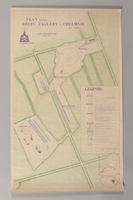
Map of the former extermination camp at Chelmno compiled by archaeologists excavating the site
Object
Hand-colored printed map of the forest camp of Chelmno killing center in German-occupied Poland, produced following archaeological excavations in 1986 and 1987. Killing operations at Chelmno were split between two locations, a manor house (Schlosslager) in the village and a camp in the Rzuchowski forest (Waldlager) 2.5 miles northwest of the village. The large number of corpses created a threat of disease and discovery by Allied forces, so the bodies were exhumed and burned in seven primitive pit furnaces. In the fall of 1942, the furnaces were replaced with two open-air crematoria consisting of concrete foundations topped by a grate of train rails. In March 1943, the manor house and open-air crematoria in the forest were demolished. Killing operations at Chelmno resumed from June to July 1944, and were carried out entirely in the forest camp, necessitating the construction of new buildings. The Germans abandoned the camp on January 17, 1945, having killed over 172,000 people. The map is a compilation of information from field photos taken in in 1958 and 1979; maps drawn in 1951, 1961, and 1987; and oral information from 1989. It identifies features found through archaeological excavations between 1951 and 1989. The excavations of 1986-87, and later work have identified additional furnaces, crematoria, and mass graves at the site.
Four eyeglass lenses recovered from Chelmno killing center
Object
Four eyeglass lenses, likely recovered from a temporary pit furnace at Chelmno killing center in German-occupied Poland, during an archaeological excavation in 1986 and 1987. Killing operations at Chelmno commenced on December 8, 1941. Prisoners were taken to a camp at a manor house (Schlosslager) in the village to undress and relinquish their valuables. They were then loaded into a gas van where they were killed. The van was then driven 2.5 miles northwest of the village to a camp in the Rzuchowski forest (Waldlager), where the bodies were dumped into mass graves. The large number of corpses created a threat of disease and discovery by Allied forces, so the bodies were exhumed and burned in seven primitive pit furnaces. In the fall of 1942, the furnaces were replaced with two open-air crematoria consisting of concrete foundations topped by a grate of train rails. In March 1943, transports to Chelmno stopped, and the manor house and open-air crematoria in the forest were demolished. Deportations to Chelmno resumed from June to July 1944, to facilitate the liquidation of the Łódź ghetto. In this second phase, the entire killing process was carried out in the forest camp (Waldlager), necessitating the construction of new buildings. The Germans abandoned the camp on January 17, 1945, having killed over 172,000 people. The excavations of 1986-87, and later work have identified additional furnaces, crematoria, and mass graves at the site.
Concrete remnants excavated from the crematorium at Chelmno killing center
Object
Concrete fragments recovered from a crematorium foundation at Chelmno killing center in German-occupied Poland, during an archaeological excavation in 1986 and 1987. Killing operations at Chelmno commenced on December 8, 1941. Prisoners were taken to a camp at a manor house (Schlosslager) in the village to undress and relinquish their valuables. They were then loaded into a gas van where they were killed. The van was then driven 2.5 miles northwest of the village to a camp in the Rzuchowski forest (Waldlager), where the bodies were dumped into mass graves. The large number of corpses created a threat of disease and discovery by Allied forces, so the bodies were exhumed and burned in seven primitive pit furnaces. In the fall of 1942, the furnaces were replaced with two open-air crematoria consisting of concrete foundations topped by a grate of train rails. The construction of the crematoria was overseen by an SS officer named Johannes Runge. In March 1943, transports to Chelmno stopped, and the manor house and open-air crematoria in the forest were demolished. Deportations to Chelmno resumed from June to July 1944 to facilitate the liquidation of the Łódź ghetto. In this second phase, the entire killing process was carried out in the forest camp, necessitating the construction of new buildings. The Germans abandoned the camp on January 17, 1945, having killed over 172,000 people. The excavations of 1986-87, and later work have identified additional furnaces, crematoria, and mass graves at the site.



